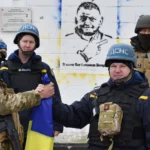This is Mike Strong, in Hays, for HPPR. The book is “The Cellist of Sarajevo” by Stephen Galloway.
As I looked up the Bosnian War and the Balkans and Yugoslavia, I kept seeing the word “diverse” to describe the population of the area. Yes, diverse, but at each other’s throats.
Having recently covered a number of diversity forums and workshops, shooting stills and video, I could only reflect on the irony that in those workshops the emphasis was on encouraging diversity as a means of cooperation, versus diversity as separate adjacent groups in the Balkans.
In November, for example, I shot video and stills for Kansas City Friends of Alvin Ailey’s annual Race, Place & Diversity award event with Olympic star Jackie Joyner-Kersee and local news anchor Qiana Thomason. White, black, young and old attended with a special youth roundtable discussion with Joyner-Kersee. The seatings were about as mixed and distributed as you could get. In older vocabulary, “integrated.”
It wasn’t that long ago that “integration” was the buzzword for living and working together in harmony, or at least a hoped for ideal of harmony. Integrating schools and lunchrooms was the work of civil rights organizing.
For a long time “integration” was a promised land. Eventually the word “integration” grew baggage as word-usage fashion began to see “integration” as meaning a form of assimilation rather than an added contribution. Somehow, “integration” had acquired the newer meaning of discarding your own cultural contributions in order to join with and be submerged into another category group.
Sometimes, the longer you use a word, the more likely it will change in meaning. From time to time there is a sort of whack-a-mole word redefining and then fleeing to find another word equivalent to the original intention. That, word too, will be in favor, until, maybe, it isn’t.
The Balkans have long been not just a geographic area with various ethnicities in close contact with each other, but also, as “Balkanization,” a word meaning fragmented and fractious. World War I, at first known as “The Great War,” touched off when a Bosnian Serb, Gavrilo Princip, assassinated Archduke Franz Ferdinand and his wife on June 28th, 1918, in Sarajevo.
For all that we think of Europe as the “Old World,” Europe’s current boundaries are relatively new. Germany and Italy were mere sets of smaller kingdoms until the late 1800’s.
Princip was one of a small set of assassins who wanted to free Bosnia and Herzegovina from Austro-Hungarian rule, creating a South Slav state comprised of Bosniaks, Croats, Macedonians, Montenegrins, Serbs and Slovenes. In a way, they achieved that. Yugoslavia (meaning South Slavia – jug=south, slavija – land of the South Slavs) – Yugoslavia was created when the Austro-Hungarian empire was carved up.
The original movement to unite South Slavs into a single Yugoslavia started in the 1830’s to unite within the Austro-Hungarian empire and the Ottoman Empire, or possibly outside the empires. The cultural and ethnic differences were never really integrated.
Here, diversity meant difference.
The borders created Yugoslavia but could not unify diverse histories, religions and language. Josip Tito was able to hold it together after World War II by force. After the 1980 death of Tito, the factions which had been there all along, became increasingly fractious, breaking out into war in 1992.
Or, as Vedran Smailovic, the real-life cellist of Sarajevo called it, “Not war, madness.”
This is Mike Strong, in Hays, for HPPR Radio Readers Book Club
Selected References:
Wikipedia entries
Published online 2014 Aug 22. doi: 10.1371/journal.pone.0105090 PMCID: PMC4141785 – PMID: 25148043 – Standing at the Gateway to Europe – The Genetic Structure of Western Balkan Populations Based on Autosomal and Haploid Markers
Contemporary inhabitants of the Balkan Peninsula belong to several ethnic groups of diverse cultural background. In this study, three ethnic groups from Bosnia and Herzegovina – Bosniacs, Bosnian Croats and Bosnian Serbs – as well as the populations of Serbians, Croatians, Macedonians from the former Yugoslav Republic of Macedonia, Montenegrins and Kosovars have been characterized for the genetic variation of 660,000 genome-wide autosomal single nucleotide polymorphisms and for haploid markers. New autosomal data of the 70 individuals together with previously published data of 20 individuals from the populations of the Western Balkan region in a context of 695 samples of global range have been analyzed. Comparison of the variation data of autosomal and haploid lineages of the studied Western Balkan populations reveals a concordance of the data in both sets and the genetic uniformity of the studied populations, especially of Western South-Slavic speakers. The genetic variation of Western Balkan populations reveals the continuity between the Middle East and Europe via the Balkan region and supports the scenario that one of the major routes of ancient gene flows and admixture went through the Balkan Peninsula.
Source : HPPR















